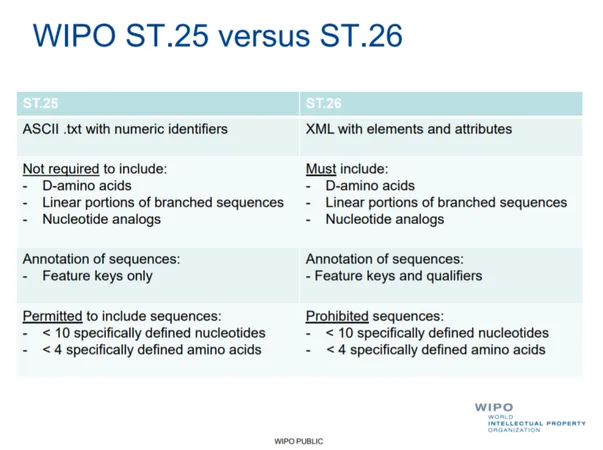A new sequence listing standard, WIPO Standard ST.26 is coming into force on 1 July 2022. On this date all WIPO member states IPOs will transition simultaneously at the International (PCT), National, and Regional levels from WIPO Standard ST.25 to ST.26.
To implement these changes at the EPO, the EPO has just published a new Decision of the President of the European Patent Office dated 9 December 2021 on the filing of sequence listings.
The background – why are sequence listings needed?#
If a patent application discloses nucleotide/amino acid sequences (in the description, claims and/or figures), a ‘sequence listing’ must be provided to the relevant IPO.
Essentially, this sequence listing contains nucleotide and/or amino acid sequences disclosed in the patent application, forms part of the description and must conform to the requirements of the relevant WIPO Standard (either ST.25; or ST.26 from 1 July 2022).
The general purpose of a sequence listing is to enable the sequence data to be searchable by an IPO and in some case by publicly available databases. For example, several Patent Offices (EPO/JIPO/KIPO/USPTO) submit sequence data to publicly searchable databases such as NCBI and EMBL. To date software, such as PatentIn and BiSSAP have been used to generate ST25 compliant sequence listings, typically provided to the IPO in a .txt format or on paper.
The changes – an overview of WIPO Standard ST.26
#
In order to ensure the acceptance of a single sequence listing worldwide, new WIPO Standard ST.26 has been adopted to replace WIPO Standard ST.25. Essentially, WIPO Standard ST.26 is a standard for the presentation of nucleotide and amino acid sequences in an XML format more closely aligned with the formats used in public databases and can also indicate characteristics of sequences, such as nucleotide analogs, D-amino acids, branched sequences), that are not presently supported by WIPO Standard ST.25.
There are many differences between WIPO ST.25 and ST.26 which are highlighted in more detail in WIPO presentation, including:

Under ST.26, and in contrast to ST.25, if a sequence comprises an undefined residue ‘n’ it does not count to the towards the minimum length requirement (10 or more specifically defined nucleotides/4 or more specifically defined amino acids), e.g:

WIPO Standard ST.26 is now an exclusively electronic, data centric format which must be presented in XML format. It will no longer be possible to file a sequence listing on paper or in a non-XML electronic format (e.g. images such as pdf) or for the purposes of an international search. These changes will be reflected in IPO filing forms from 1 July 2022.
WIPO has also developed new software for the generation and validation of sequence listings to ensure compliance with ST.26 – WIPO Sequence and WIPO Sequence Validator. It is not obligatory to use this tool, and some applicants have developed proprietary tools, however, to ensure compliance with ST.26 use of WIPO Sequence is recommended.
Take home advice#
In advance of 1 July 2022, be prepared for these changes and get familiar with the new filing software, WIPO Sequence, and XML requirements. It is important to note the following:
- The patent application filing date will be the reference date that determines if an application falls under ST.25 or ST.26 sequence rules, not the priority date.
- ST.25 will remain effective for patent applications with a filing date prior to 1 July, 2022.
- However,
if a patent application has a filing date after 1 July 2022 but claims
priority from an application with an ST.25 sequence listing, at the EPO,
it will be necessary to convert that sequence listing from ST.25 to ST.26.
- This will impact new divisional applications. Although a matter of national law, the recommendation is for divisional applications to be compliant with WIPO ST.26
- For the accordance of a date of filing at the EPO, it is sufficient for an applicant to file a description and a set of claims. Where the description contains sequences that are supposed to be presented as part of a sequence listing, a formal defect will be raised. For example, in accordance with the recent EPO Decision, where an applicant does not file a ST.26 compliant sequence listing on the date of filing of a European Patent Application, the EPO will invite the applicant to file a ST.26 compliant sequence listing within a 2-month term and require the payment of a late furnishing fee. The ST.26 sequence listing must not go beyond the disclosure in the international application as filed and must be accompanied by a statement to that effect.
During this transition phase, our advice is to ensure the sequence listing is prepared well in advance. This is particularly important where conversion of a ST.25 sequence listing format to ST.26 format will be required as this is likely to require applicant input.





















